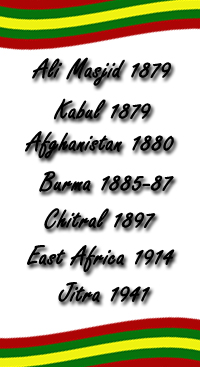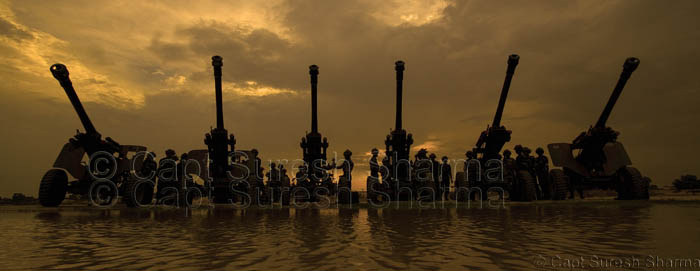
The Punjab was annexed at the end of the second Sikh war in 1849 and the Punjab Irregular Frontier Force (the "Piffers") formed to maintain order amongst the Pathan hillmen. The 4th (Hazara) Mountain Artillery Battery was established in 1848 and added to the original "Piffers" in 1856. The "Piffers" were raised in khaki, and many wore nothing else although full dress for mountain batteries was supposed to be a blue with red facings similar to the RA. Noteworthy are the loose Indian slippers which suited the hill-work, and the artillery sword. Sikh Gunners became associated with the finest traditions of Gunnery during the "Sikh wars". To great British cost Sikh batteries established their norm of serving the guns to the very last man. After many attempts to solve the problem of providing effective artillery support in challenging hill country, the solution was found in the pack-gun, carried on mules. The newly forming mountain batteries made the most of the high standards by deliberately enlisting a large proportion of Sikhs. So began the legend of these "big men with little guns". Their reputation quickly spread far beyond the Northwest frontier of India and contributed to mountain artillery becoming a separate branch, with its own depot, traditions, a unique and strong esprit de corps, and an ethos that continues to demand respect The 4th was one of 4 field and 2 mountain batteries. The "Piffers" standing was so high that none of them were transferred when all other Indian artillery was moved to the RA after the "Mutiny". Later two of the field batteries were disbanded and the remaining two converted to mountain Artillery. In 1860 two Bombay field batteries became mountain batteries, and four more were subsequently raised. Like all mountain batteries the 4th was almost continuously in action, serving several of the pack-guns, including the "screw-gun" immortalised by Kipling. Initially it was raised from Hazara gunners to help defend the Hazara District of the North-West Frontier. Later it helped Sir Sam Browne take the Khyber. It was at the relief of Kabul, remaining there until it joined Roberts on his march on Kandahar. 1885-87 found it in Burma, 1895 on the Indian Frontier as part of the Chitral Relief Force. WWI saw it deployed to East Africa in 1917, where it remained until Armistice. Afterwards it saw service in the Third Afghan War, the Red Shirt and Afridi Disturbances, the Mohmand Campaign, and operated against the Fakir of Ipi in Waziristan. It was deployed to Singapore at the opening of WWII in 1939, where, for the first time in its remarkable heritage, it was lost because of the capitulation. One of its most famous achievements occurred in 1891 when it moved out from Bannu to cross the Himalayas. Operating at altitudes between 11,500 and 13,000 feet, the battery marched 540 miles - successfully fighting the entire distance. Inexplicably not a single member has been recognised with a VC. Understandably Indian Artillery dates its origins to the mountain batteries and takes its "Raising Day" as 28 September 1827. This is the formation date of 4th's sister, 5 (Bombay) Mountain Battery.





No comments:
Post a Comment